Worknet Technologies: Information System Development Methodologies
VerifiedAdded on 2023/04/21
|13
|3031
|296
Report
AI Summary
This report discusses the development of a new database system at Worknet Technologies, which currently manages data manually, leading to potential data loss and lack of inter-branch connectivity. The report analyzes the necessary framework for developing the new database system, provides a comparative analysis of different Information System Development (ISD) methods, including the Waterfall, Spiral, and Incremental models, and recommends the Waterfall method as the most suitable for the company. The Waterfall model's phases, such as requirement gathering, system design, implementation, testing, deployment, and maintenance, are detailed. The report concludes by highlighting the benefits of implementing the new database system for effective data management across all branches of the organization.
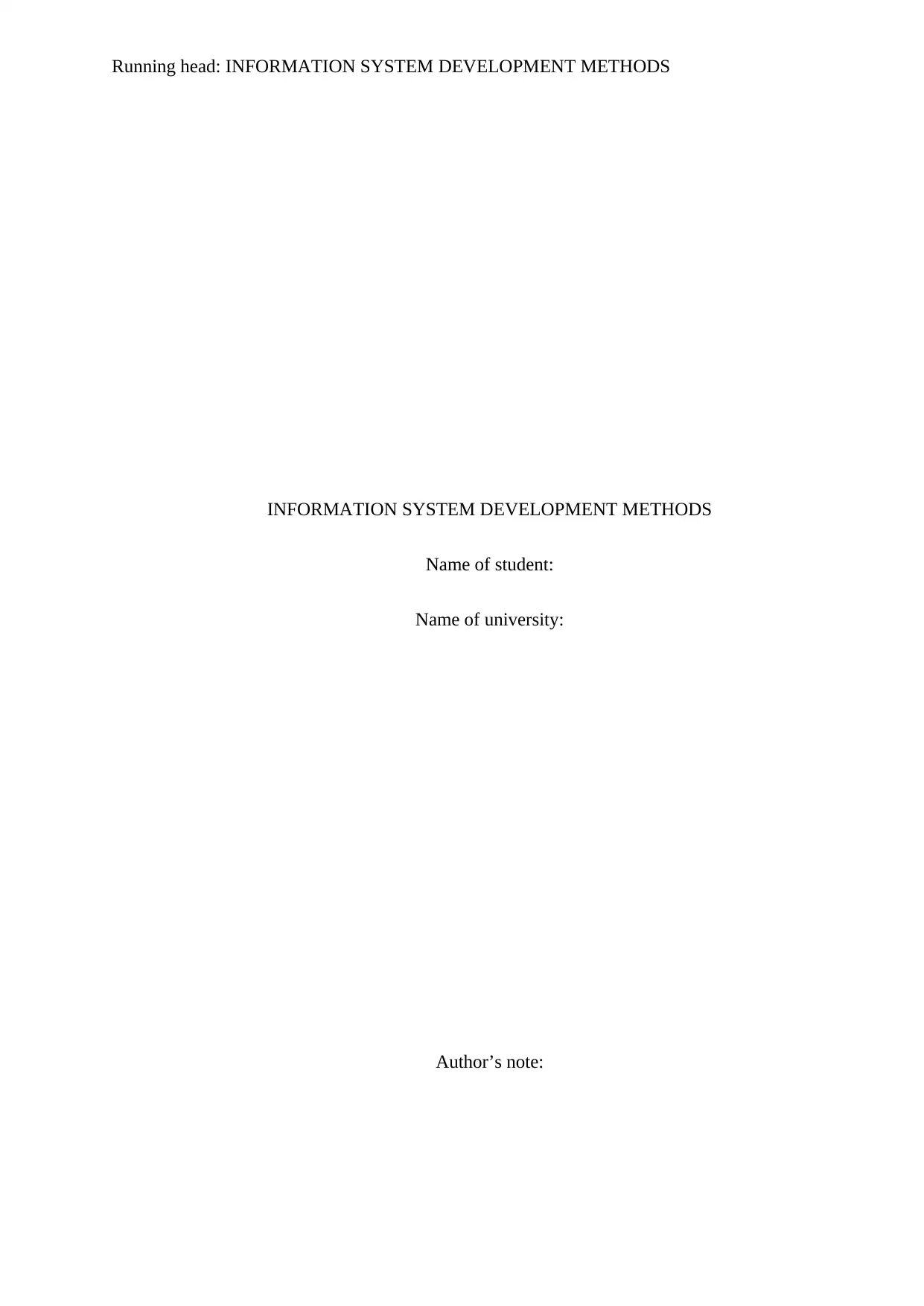
Running head: INFORMATION SYSTEM DEVELOPMENT METHODS
INFORMATION SYSTEM DEVELOPMENT METHODS
Name of student:
Name of university:
Author’s note:
INFORMATION SYSTEM DEVELOPMENT METHODS
Name of student:
Name of university:
Author’s note:
Paraphrase This Document
Need a fresh take? Get an instant paraphrase of this document with our AI Paraphraser
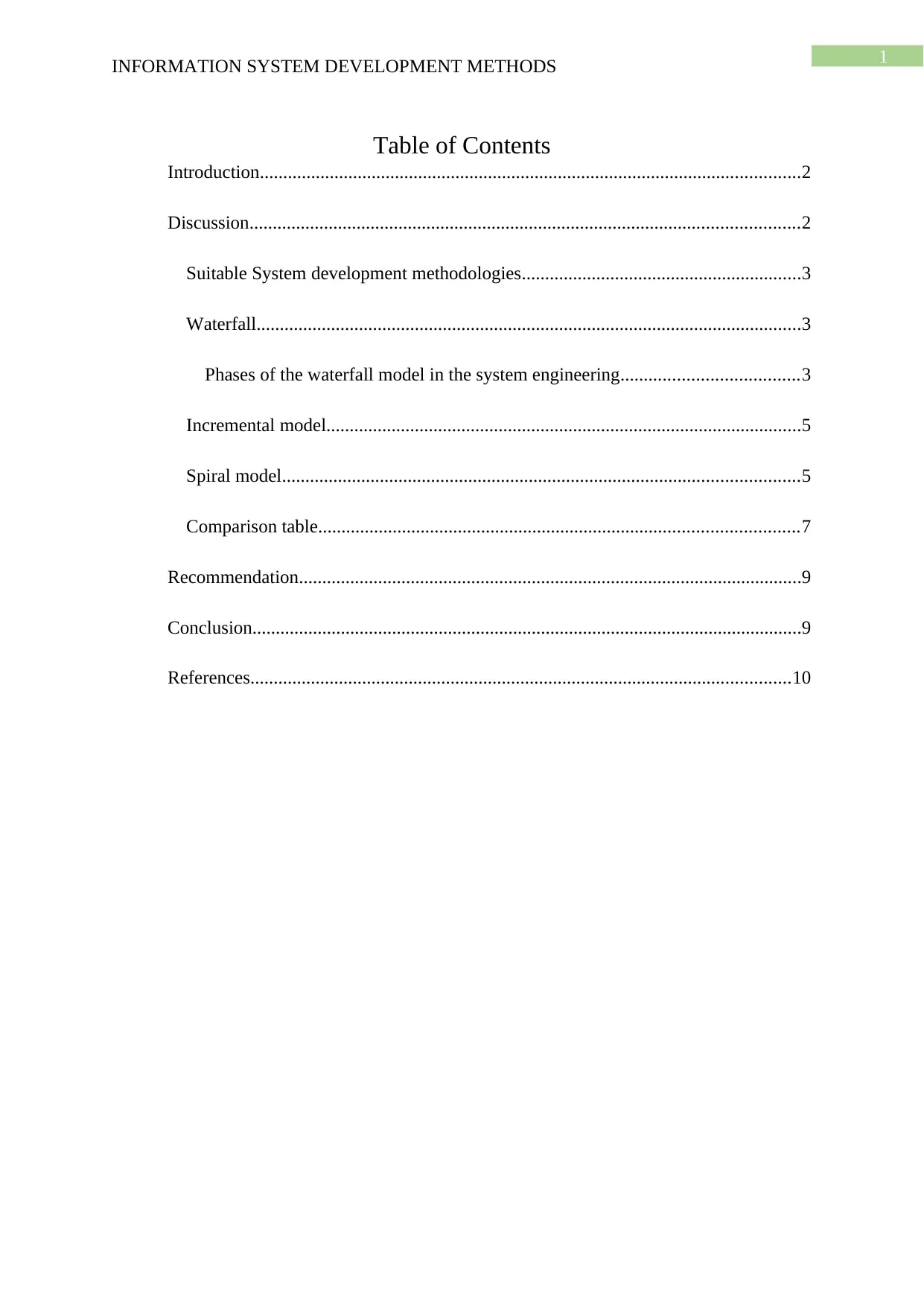
1
INFORMATION SYSTEM DEVELOPMENT METHODS
Table of Contents
Introduction....................................................................................................................2
Discussion......................................................................................................................2
Suitable System development methodologies............................................................3
Waterfall.....................................................................................................................3
Phases of the waterfall model in the system engineering......................................3
Incremental model......................................................................................................5
Spiral model...............................................................................................................5
Comparison table.......................................................................................................7
Recommendation............................................................................................................9
Conclusion......................................................................................................................9
References....................................................................................................................10
INFORMATION SYSTEM DEVELOPMENT METHODS
Table of Contents
Introduction....................................................................................................................2
Discussion......................................................................................................................2
Suitable System development methodologies............................................................3
Waterfall.....................................................................................................................3
Phases of the waterfall model in the system engineering......................................3
Incremental model......................................................................................................5
Spiral model...............................................................................................................5
Comparison table.......................................................................................................7
Recommendation............................................................................................................9
Conclusion......................................................................................................................9
References....................................................................................................................10
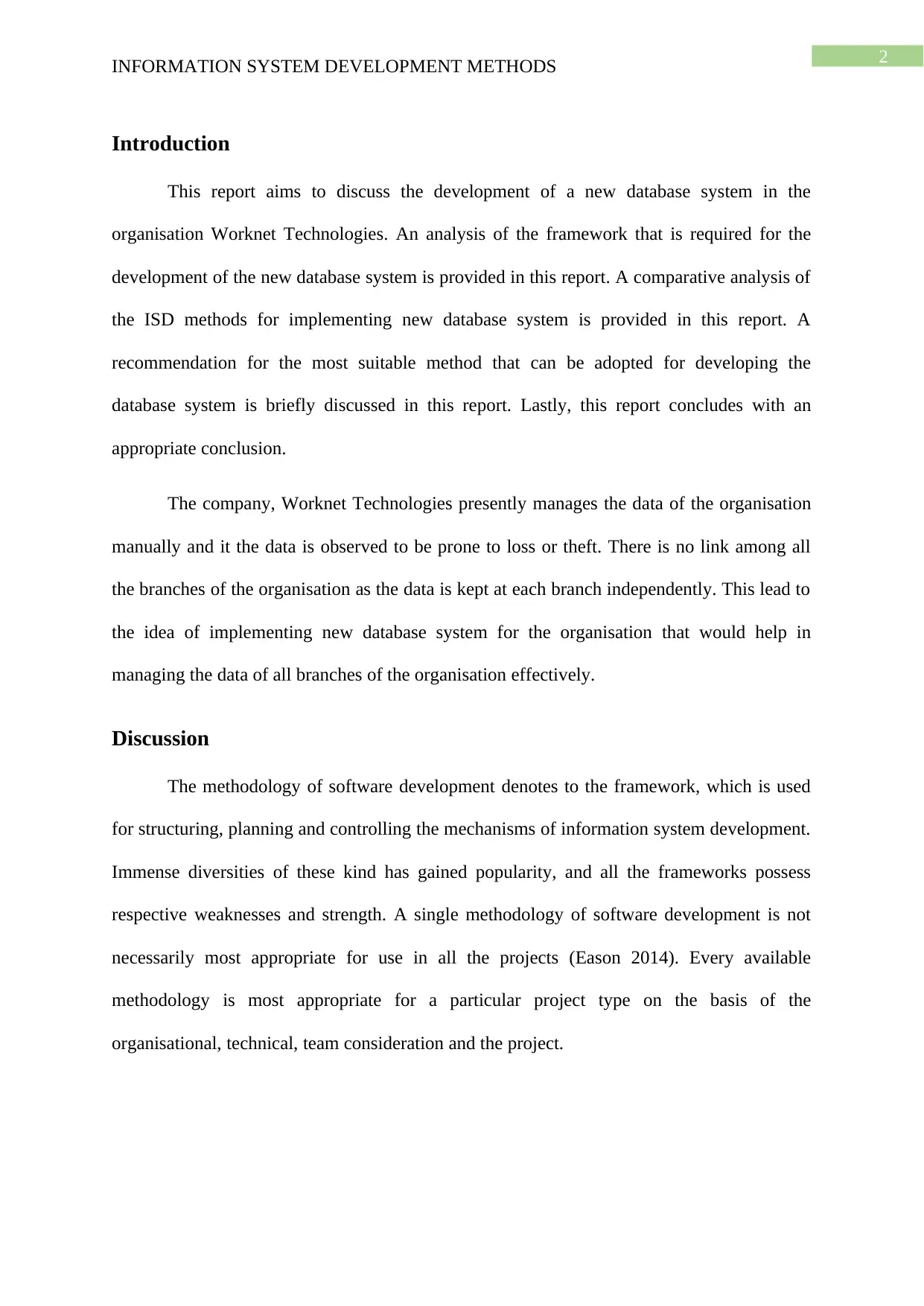
2
INFORMATION SYSTEM DEVELOPMENT METHODS
Introduction
This report aims to discuss the development of a new database system in the
organisation Worknet Technologies. An analysis of the framework that is required for the
development of the new database system is provided in this report. A comparative analysis of
the ISD methods for implementing new database system is provided in this report. A
recommendation for the most suitable method that can be adopted for developing the
database system is briefly discussed in this report. Lastly, this report concludes with an
appropriate conclusion.
The company, Worknet Technologies presently manages the data of the organisation
manually and it the data is observed to be prone to loss or theft. There is no link among all
the branches of the organisation as the data is kept at each branch independently. This lead to
the idea of implementing new database system for the organisation that would help in
managing the data of all branches of the organisation effectively.
Discussion
The methodology of software development denotes to the framework, which is used
for structuring, planning and controlling the mechanisms of information system development.
Immense diversities of these kind has gained popularity, and all the frameworks possess
respective weaknesses and strength. A single methodology of software development is not
necessarily most appropriate for use in all the projects (Eason 2014). Every available
methodology is most appropriate for a particular project type on the basis of the
organisational, technical, team consideration and the project.
INFORMATION SYSTEM DEVELOPMENT METHODS
Introduction
This report aims to discuss the development of a new database system in the
organisation Worknet Technologies. An analysis of the framework that is required for the
development of the new database system is provided in this report. A comparative analysis of
the ISD methods for implementing new database system is provided in this report. A
recommendation for the most suitable method that can be adopted for developing the
database system is briefly discussed in this report. Lastly, this report concludes with an
appropriate conclusion.
The company, Worknet Technologies presently manages the data of the organisation
manually and it the data is observed to be prone to loss or theft. There is no link among all
the branches of the organisation as the data is kept at each branch independently. This lead to
the idea of implementing new database system for the organisation that would help in
managing the data of all branches of the organisation effectively.
Discussion
The methodology of software development denotes to the framework, which is used
for structuring, planning and controlling the mechanisms of information system development.
Immense diversities of these kind has gained popularity, and all the frameworks possess
respective weaknesses and strength. A single methodology of software development is not
necessarily most appropriate for use in all the projects (Eason 2014). Every available
methodology is most appropriate for a particular project type on the basis of the
organisational, technical, team consideration and the project.
⊘ This is a preview!⊘
Do you want full access?
Subscribe today to unlock all pages.

Trusted by 1+ million students worldwide
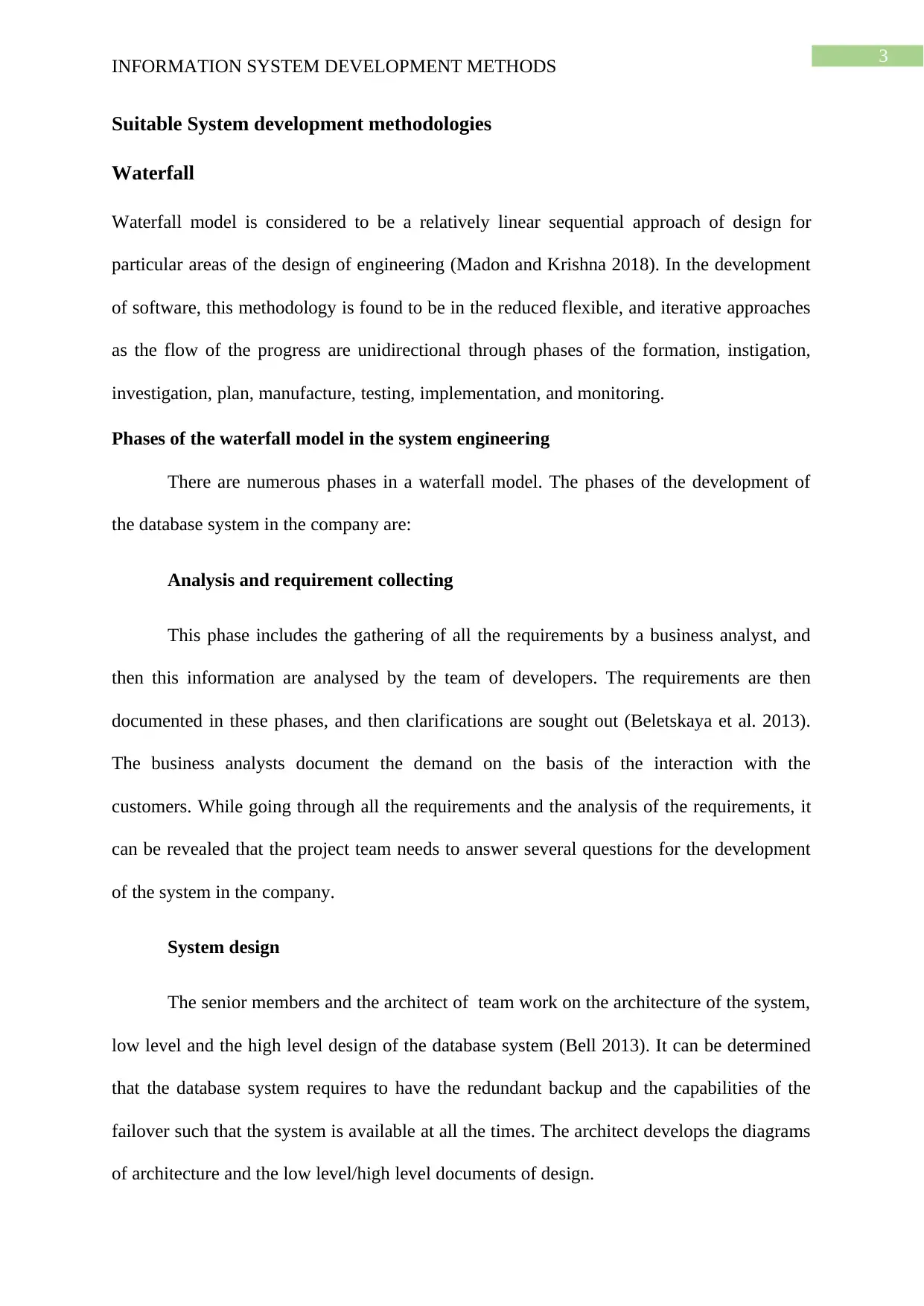
3
INFORMATION SYSTEM DEVELOPMENT METHODS
Suitable System development methodologies
Waterfall
Waterfall model is considered to be a relatively linear sequential approach of design for
particular areas of the design of engineering (Madon and Krishna 2018). In the development
of software, this methodology is found to be in the reduced flexible, and iterative approaches
as the flow of the progress are unidirectional through phases of the formation, instigation,
investigation, plan, manufacture, testing, implementation, and monitoring.
Phases of the waterfall model in the system engineering
There are numerous phases in a waterfall model. The phases of the development of
the database system in the company are:
Analysis and requirement collecting
This phase includes the gathering of all the requirements by a business analyst, and
then this information are analysed by the team of developers. The requirements are then
documented in these phases, and then clarifications are sought out (Beletskaya et al. 2013).
The business analysts document the demand on the basis of the interaction with the
customers. While going through all the requirements and the analysis of the requirements, it
can be revealed that the project team needs to answer several questions for the development
of the system in the company.
System design
The senior members and the architect of team work on the architecture of the system,
low level and the high level design of the database system (Bell 2013). It can be determined
that the database system requires to have the redundant backup and the capabilities of the
failover such that the system is available at all the times. The architect develops the diagrams
of architecture and the low level/high level documents of design.
INFORMATION SYSTEM DEVELOPMENT METHODS
Suitable System development methodologies
Waterfall
Waterfall model is considered to be a relatively linear sequential approach of design for
particular areas of the design of engineering (Madon and Krishna 2018). In the development
of software, this methodology is found to be in the reduced flexible, and iterative approaches
as the flow of the progress are unidirectional through phases of the formation, instigation,
investigation, plan, manufacture, testing, implementation, and monitoring.
Phases of the waterfall model in the system engineering
There are numerous phases in a waterfall model. The phases of the development of
the database system in the company are:
Analysis and requirement collecting
This phase includes the gathering of all the requirements by a business analyst, and
then this information are analysed by the team of developers. The requirements are then
documented in these phases, and then clarifications are sought out (Beletskaya et al. 2013).
The business analysts document the demand on the basis of the interaction with the
customers. While going through all the requirements and the analysis of the requirements, it
can be revealed that the project team needs to answer several questions for the development
of the system in the company.
System design
The senior members and the architect of team work on the architecture of the system,
low level and the high level design of the database system (Bell 2013). It can be determined
that the database system requires to have the redundant backup and the capabilities of the
failover such that the system is available at all the times. The architect develops the diagrams
of architecture and the low level/high level documents of design.
Paraphrase This Document
Need a fresh take? Get an instant paraphrase of this document with our AI Paraphraser
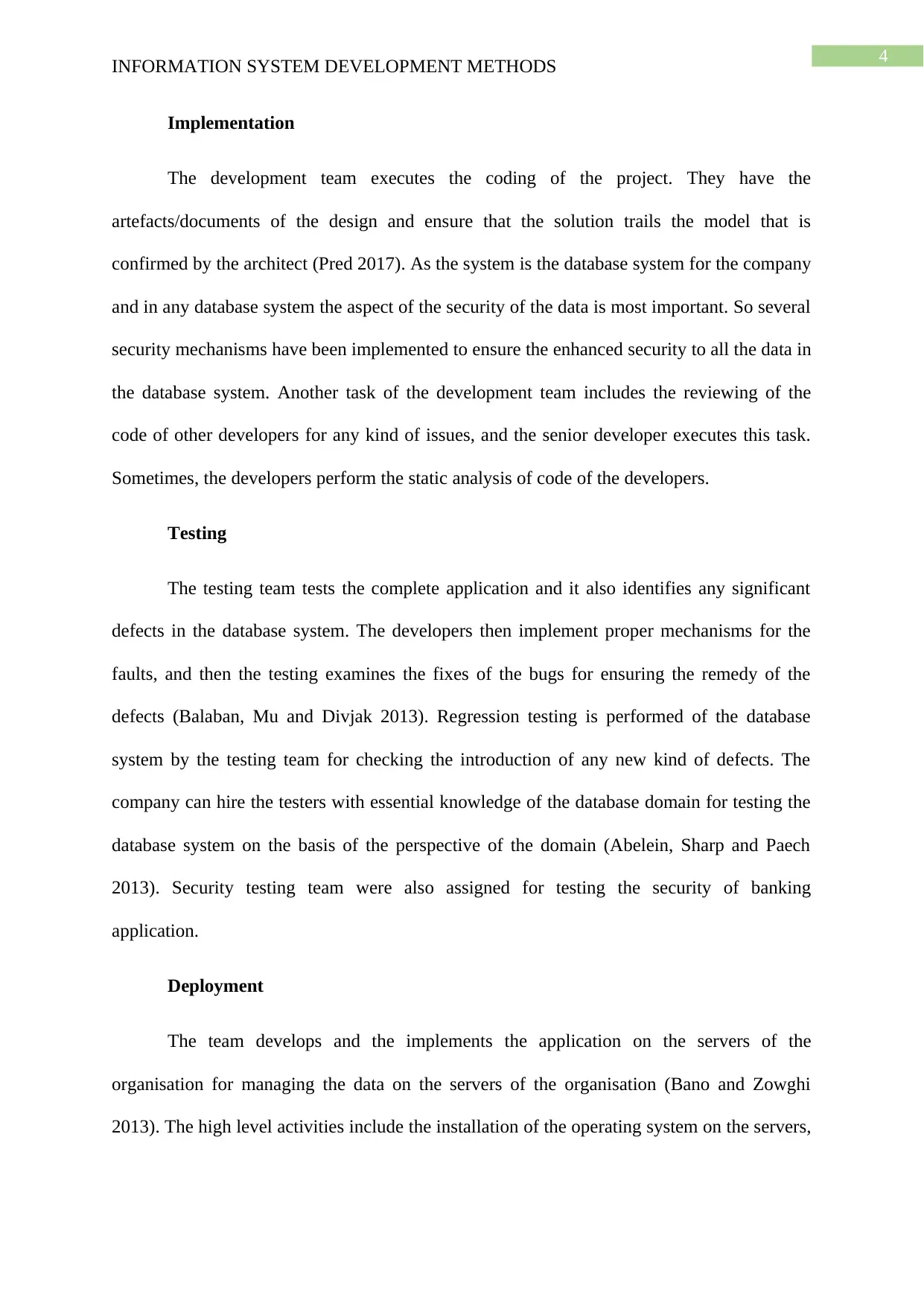
4
INFORMATION SYSTEM DEVELOPMENT METHODS
Implementation
The development team executes the coding of the project. They have the
artefacts/documents of the design and ensure that the solution trails the model that is
confirmed by the architect (Pred 2017). As the system is the database system for the company
and in any database system the aspect of the security of the data is most important. So several
security mechanisms have been implemented to ensure the enhanced security to all the data in
the database system. Another task of the development team includes the reviewing of the
code of other developers for any kind of issues, and the senior developer executes this task.
Sometimes, the developers perform the static analysis of code of the developers.
Testing
The testing team tests the complete application and it also identifies any significant
defects in the database system. The developers then implement proper mechanisms for the
faults, and then the testing examines the fixes of the bugs for ensuring the remedy of the
defects (Balaban, Mu and Divjak 2013). Regression testing is performed of the database
system by the testing team for checking the introduction of any new kind of defects. The
company can hire the testers with essential knowledge of the database domain for testing the
database system on the basis of the perspective of the domain (Abelein, Sharp and Paech
2013). Security testing team were also assigned for testing the security of banking
application.
Deployment
The team develops and the implements the application on the servers of the
organisation for managing the data on the servers of the organisation (Bano and Zowghi
2013). The high level activities include the installation of the operating system on the servers,
INFORMATION SYSTEM DEVELOPMENT METHODS
Implementation
The development team executes the coding of the project. They have the
artefacts/documents of the design and ensure that the solution trails the model that is
confirmed by the architect (Pred 2017). As the system is the database system for the company
and in any database system the aspect of the security of the data is most important. So several
security mechanisms have been implemented to ensure the enhanced security to all the data in
the database system. Another task of the development team includes the reviewing of the
code of other developers for any kind of issues, and the senior developer executes this task.
Sometimes, the developers perform the static analysis of code of the developers.
Testing
The testing team tests the complete application and it also identifies any significant
defects in the database system. The developers then implement proper mechanisms for the
faults, and then the testing examines the fixes of the bugs for ensuring the remedy of the
defects (Balaban, Mu and Divjak 2013). Regression testing is performed of the database
system by the testing team for checking the introduction of any new kind of defects. The
company can hire the testers with essential knowledge of the database domain for testing the
database system on the basis of the perspective of the domain (Abelein, Sharp and Paech
2013). Security testing team were also assigned for testing the security of banking
application.
Deployment
The team develops and the implements the application on the servers of the
organisation for managing the data on the servers of the organisation (Bano and Zowghi
2013). The high level activities include the installation of the operating system on the servers,
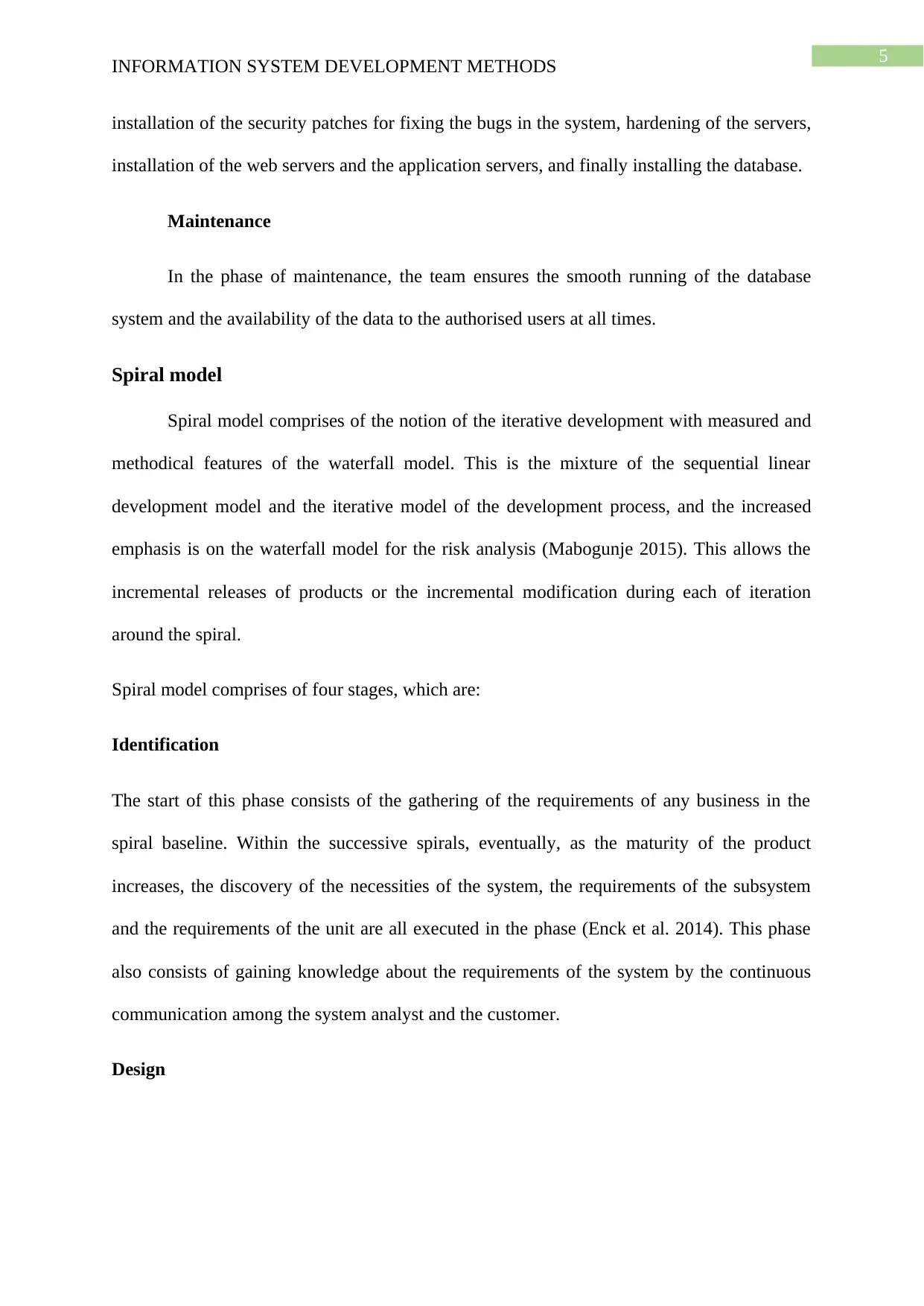
5
INFORMATION SYSTEM DEVELOPMENT METHODS
installation of the security patches for fixing the bugs in the system, hardening of the servers,
installation of the web servers and the application servers, and finally installing the database.
Maintenance
In the phase of maintenance, the team ensures the smooth running of the database
system and the availability of the data to the authorised users at all times.
Spiral model
Spiral model comprises of the notion of the iterative development with measured and
methodical features of the waterfall model. This is the mixture of the sequential linear
development model and the iterative model of the development process, and the increased
emphasis is on the waterfall model for the risk analysis (Mabogunje 2015). This allows the
incremental releases of products or the incremental modification during each of iteration
around the spiral.
Spiral model comprises of four stages, which are:
Identification
The start of this phase consists of the gathering of the requirements of any business in the
spiral baseline. Within the successive spirals, eventually, as the maturity of the product
increases, the discovery of the necessities of the system, the requirements of the subsystem
and the requirements of the unit are all executed in the phase (Enck et al. 2014). This phase
also consists of gaining knowledge about the requirements of the system by the continuous
communication among the system analyst and the customer.
Design
INFORMATION SYSTEM DEVELOPMENT METHODS
installation of the security patches for fixing the bugs in the system, hardening of the servers,
installation of the web servers and the application servers, and finally installing the database.
Maintenance
In the phase of maintenance, the team ensures the smooth running of the database
system and the availability of the data to the authorised users at all times.
Spiral model
Spiral model comprises of the notion of the iterative development with measured and
methodical features of the waterfall model. This is the mixture of the sequential linear
development model and the iterative model of the development process, and the increased
emphasis is on the waterfall model for the risk analysis (Mabogunje 2015). This allows the
incremental releases of products or the incremental modification during each of iteration
around the spiral.
Spiral model comprises of four stages, which are:
Identification
The start of this phase consists of the gathering of the requirements of any business in the
spiral baseline. Within the successive spirals, eventually, as the maturity of the product
increases, the discovery of the necessities of the system, the requirements of the subsystem
and the requirements of the unit are all executed in the phase (Enck et al. 2014). This phase
also consists of gaining knowledge about the requirements of the system by the continuous
communication among the system analyst and the customer.
Design
⊘ This is a preview!⊘
Do you want full access?
Subscribe today to unlock all pages.

Trusted by 1+ million students worldwide
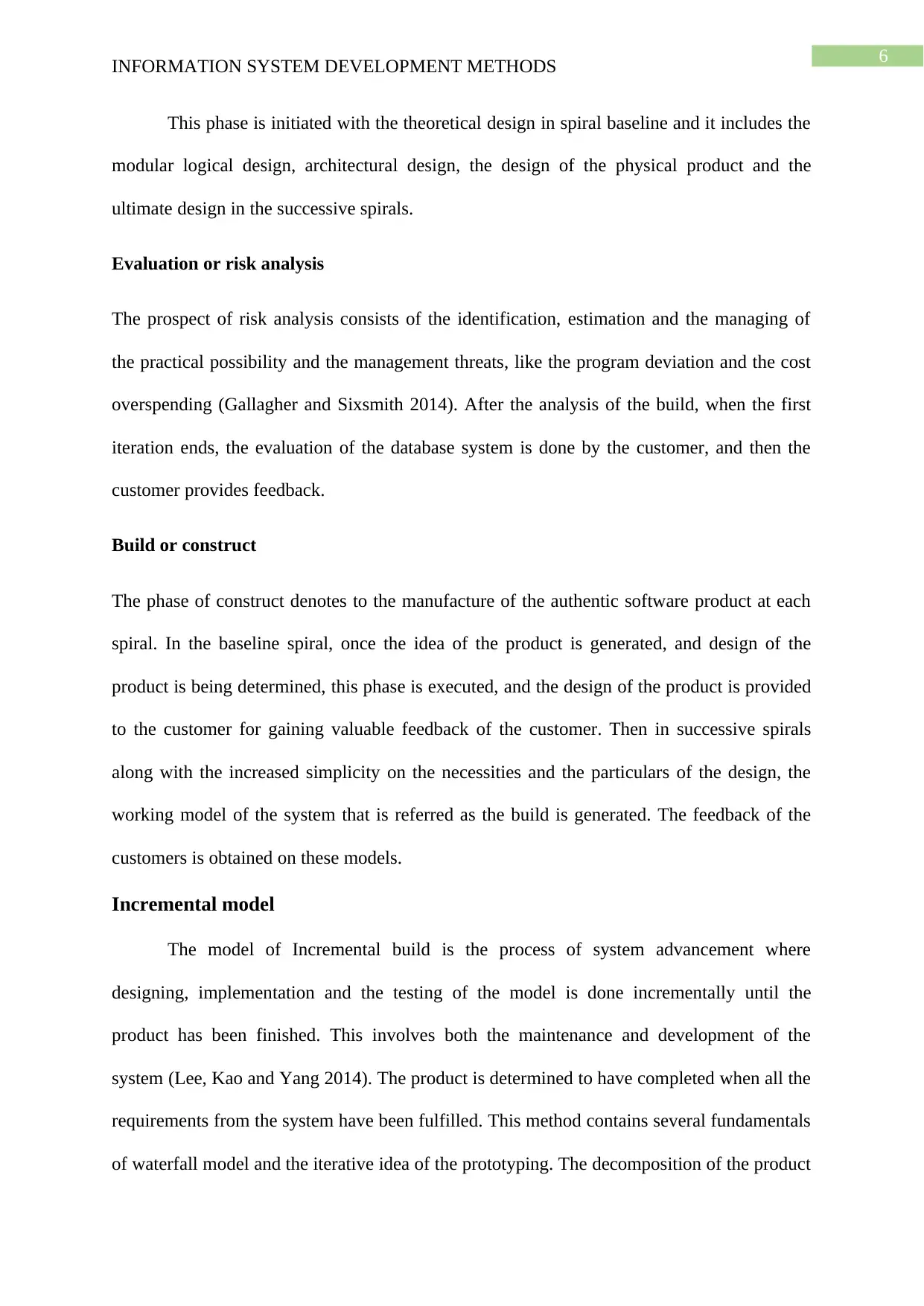
6
INFORMATION SYSTEM DEVELOPMENT METHODS
This phase is initiated with the theoretical design in spiral baseline and it includes the
modular logical design, architectural design, the design of the physical product and the
ultimate design in the successive spirals.
Evaluation or risk analysis
The prospect of risk analysis consists of the identification, estimation and the managing of
the practical possibility and the management threats, like the program deviation and the cost
overspending (Gallagher and Sixsmith 2014). After the analysis of the build, when the first
iteration ends, the evaluation of the database system is done by the customer, and then the
customer provides feedback.
Build or construct
The phase of construct denotes to the manufacture of the authentic software product at each
spiral. In the baseline spiral, once the idea of the product is generated, and design of the
product is being determined, this phase is executed, and the design of the product is provided
to the customer for gaining valuable feedback of the customer. Then in successive spirals
along with the increased simplicity on the necessities and the particulars of the design, the
working model of the system that is referred as the build is generated. The feedback of the
customers is obtained on these models.
Incremental model
The model of Incremental build is the process of system advancement where
designing, implementation and the testing of the model is done incrementally until the
product has been finished. This involves both the maintenance and development of the
system (Lee, Kao and Yang 2014). The product is determined to have completed when all the
requirements from the system have been fulfilled. This method contains several fundamentals
of waterfall model and the iterative idea of the prototyping. The decomposition of the product
INFORMATION SYSTEM DEVELOPMENT METHODS
This phase is initiated with the theoretical design in spiral baseline and it includes the
modular logical design, architectural design, the design of the physical product and the
ultimate design in the successive spirals.
Evaluation or risk analysis
The prospect of risk analysis consists of the identification, estimation and the managing of
the practical possibility and the management threats, like the program deviation and the cost
overspending (Gallagher and Sixsmith 2014). After the analysis of the build, when the first
iteration ends, the evaluation of the database system is done by the customer, and then the
customer provides feedback.
Build or construct
The phase of construct denotes to the manufacture of the authentic software product at each
spiral. In the baseline spiral, once the idea of the product is generated, and design of the
product is being determined, this phase is executed, and the design of the product is provided
to the customer for gaining valuable feedback of the customer. Then in successive spirals
along with the increased simplicity on the necessities and the particulars of the design, the
working model of the system that is referred as the build is generated. The feedback of the
customers is obtained on these models.
Incremental model
The model of Incremental build is the process of system advancement where
designing, implementation and the testing of the model is done incrementally until the
product has been finished. This involves both the maintenance and development of the
system (Lee, Kao and Yang 2014). The product is determined to have completed when all the
requirements from the system have been fulfilled. This method contains several fundamentals
of waterfall model and the iterative idea of the prototyping. The decomposition of the product
Paraphrase This Document
Need a fresh take? Get an instant paraphrase of this document with our AI Paraphraser
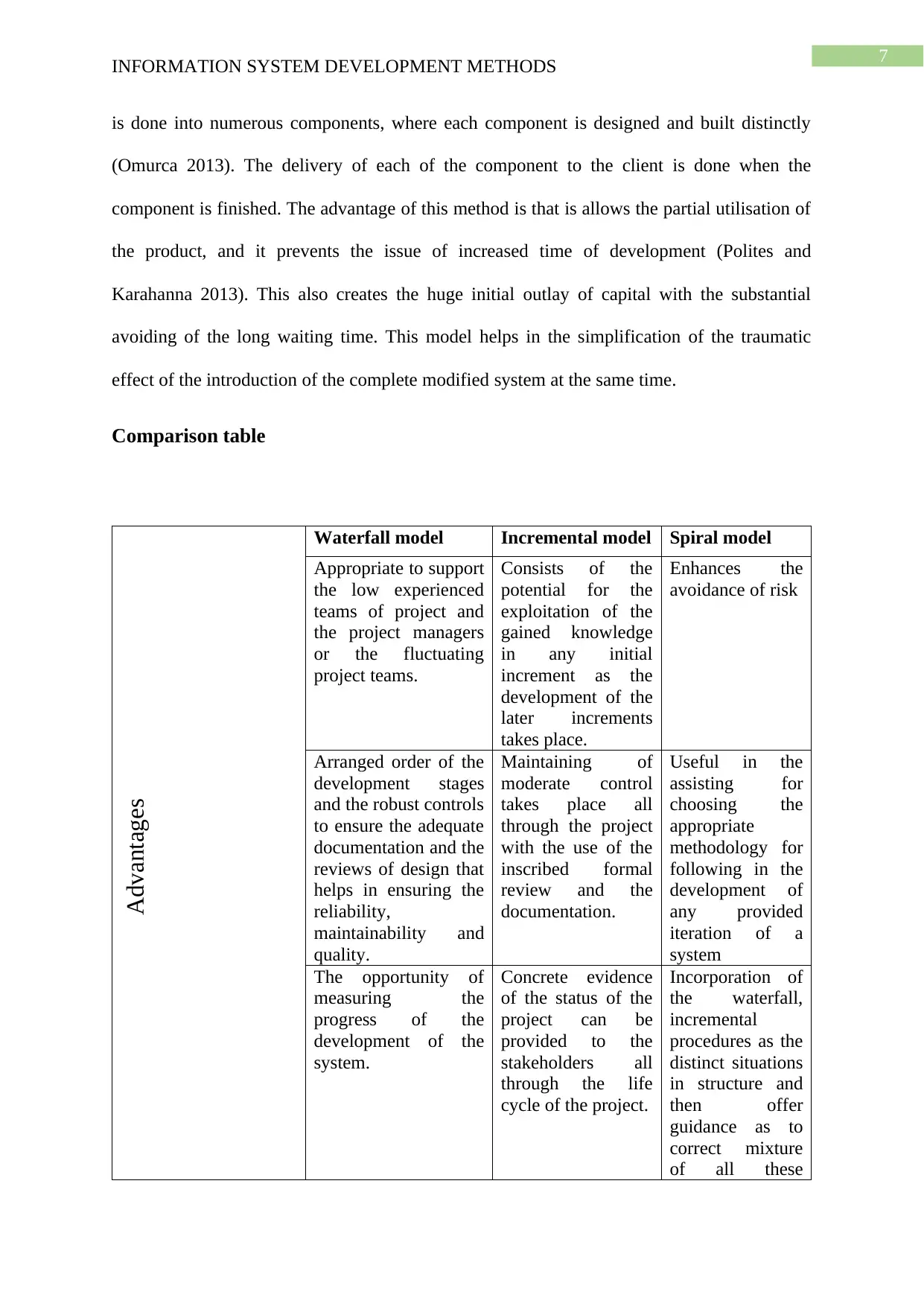
7
INFORMATION SYSTEM DEVELOPMENT METHODS
is done into numerous components, where each component is designed and built distinctly
(Omurca 2013). The delivery of each of the component to the client is done when the
component is finished. The advantage of this method is that is allows the partial utilisation of
the product, and it prevents the issue of increased time of development (Polites and
Karahanna 2013). This also creates the huge initial outlay of capital with the substantial
avoiding of the long waiting time. This model helps in the simplification of the traumatic
effect of the introduction of the complete modified system at the same time.
Comparison table
Advantages
Waterfall model Incremental model Spiral model
Appropriate to support
the low experienced
teams of project and
the project managers
or the fluctuating
project teams.
Consists of the
potential for the
exploitation of the
gained knowledge
in any initial
increment as the
development of the
later increments
takes place.
Enhances the
avoidance of risk
Arranged order of the
development stages
and the robust controls
to ensure the adequate
documentation and the
reviews of design that
helps in ensuring the
reliability,
maintainability and
quality.
Maintaining of
moderate control
takes place all
through the project
with the use of the
inscribed formal
review and the
documentation.
Useful in the
assisting for
choosing the
appropriate
methodology for
following in the
development of
any provided
iteration of a
system
The opportunity of
measuring the
progress of the
development of the
system.
Concrete evidence
of the status of the
project can be
provided to the
stakeholders all
through the life
cycle of the project.
Incorporation of
the waterfall,
incremental
procedures as the
distinct situations
in structure and
then offer
guidance as to
correct mixture
of all these
INFORMATION SYSTEM DEVELOPMENT METHODS
is done into numerous components, where each component is designed and built distinctly
(Omurca 2013). The delivery of each of the component to the client is done when the
component is finished. The advantage of this method is that is allows the partial utilisation of
the product, and it prevents the issue of increased time of development (Polites and
Karahanna 2013). This also creates the huge initial outlay of capital with the substantial
avoiding of the long waiting time. This model helps in the simplification of the traumatic
effect of the introduction of the complete modified system at the same time.
Comparison table
Advantages
Waterfall model Incremental model Spiral model
Appropriate to support
the low experienced
teams of project and
the project managers
or the fluctuating
project teams.
Consists of the
potential for the
exploitation of the
gained knowledge
in any initial
increment as the
development of the
later increments
takes place.
Enhances the
avoidance of risk
Arranged order of the
development stages
and the robust controls
to ensure the adequate
documentation and the
reviews of design that
helps in ensuring the
reliability,
maintainability and
quality.
Maintaining of
moderate control
takes place all
through the project
with the use of the
inscribed formal
review and the
documentation.
Useful in the
assisting for
choosing the
appropriate
methodology for
following in the
development of
any provided
iteration of a
system
The opportunity of
measuring the
progress of the
development of the
system.
Concrete evidence
of the status of the
project can be
provided to the
stakeholders all
through the life
cycle of the project.
Incorporation of
the waterfall,
incremental
procedures as the
distinct situations
in structure and
then offer
guidance as to
correct mixture
of all these
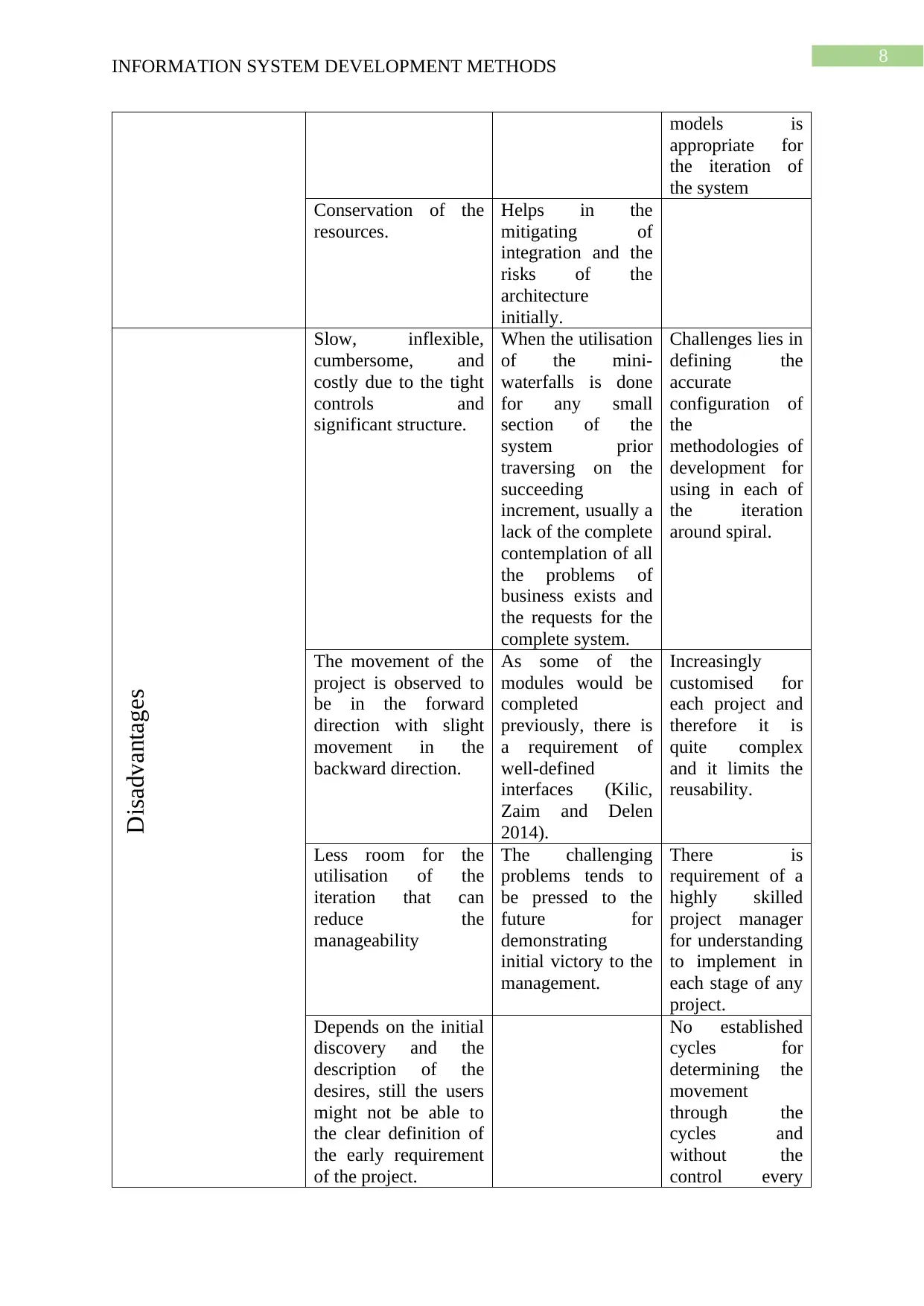
8
INFORMATION SYSTEM DEVELOPMENT METHODS
models is
appropriate for
the iteration of
the system
Conservation of the
resources.
Helps in the
mitigating of
integration and the
risks of the
architecture
initially.
Disadvantages
Slow, inflexible,
cumbersome, and
costly due to the tight
controls and
significant structure.
When the utilisation
of the mini-
waterfalls is done
for any small
section of the
system prior
traversing on the
succeeding
increment, usually a
lack of the complete
contemplation of all
the problems of
business exists and
the requests for the
complete system.
Challenges lies in
defining the
accurate
configuration of
the
methodologies of
development for
using in each of
the iteration
around spiral.
The movement of the
project is observed to
be in the forward
direction with slight
movement in the
backward direction.
As some of the
modules would be
completed
previously, there is
a requirement of
well-defined
interfaces (Kilic,
Zaim and Delen
2014).
Increasingly
customised for
each project and
therefore it is
quite complex
and it limits the
reusability.
Less room for the
utilisation of the
iteration that can
reduce the
manageability
The challenging
problems tends to
be pressed to the
future for
demonstrating
initial victory to the
management.
There is
requirement of a
highly skilled
project manager
for understanding
to implement in
each stage of any
project.
Depends on the initial
discovery and the
description of the
desires, still the users
might not be able to
the clear definition of
the early requirement
of the project.
No established
cycles for
determining the
movement
through the
cycles and
without the
control every
INFORMATION SYSTEM DEVELOPMENT METHODS
models is
appropriate for
the iteration of
the system
Conservation of the
resources.
Helps in the
mitigating of
integration and the
risks of the
architecture
initially.
Disadvantages
Slow, inflexible,
cumbersome, and
costly due to the tight
controls and
significant structure.
When the utilisation
of the mini-
waterfalls is done
for any small
section of the
system prior
traversing on the
succeeding
increment, usually a
lack of the complete
contemplation of all
the problems of
business exists and
the requests for the
complete system.
Challenges lies in
defining the
accurate
configuration of
the
methodologies of
development for
using in each of
the iteration
around spiral.
The movement of the
project is observed to
be in the forward
direction with slight
movement in the
backward direction.
As some of the
modules would be
completed
previously, there is
a requirement of
well-defined
interfaces (Kilic,
Zaim and Delen
2014).
Increasingly
customised for
each project and
therefore it is
quite complex
and it limits the
reusability.
Less room for the
utilisation of the
iteration that can
reduce the
manageability
The challenging
problems tends to
be pressed to the
future for
demonstrating
initial victory to the
management.
There is
requirement of a
highly skilled
project manager
for understanding
to implement in
each stage of any
project.
Depends on the initial
discovery and the
description of the
desires, still the users
might not be able to
the clear definition of
the early requirement
of the project.
No established
cycles for
determining the
movement
through the
cycles and
without the
control every
⊘ This is a preview!⊘
Do you want full access?
Subscribe today to unlock all pages.

Trusted by 1+ million students worldwide
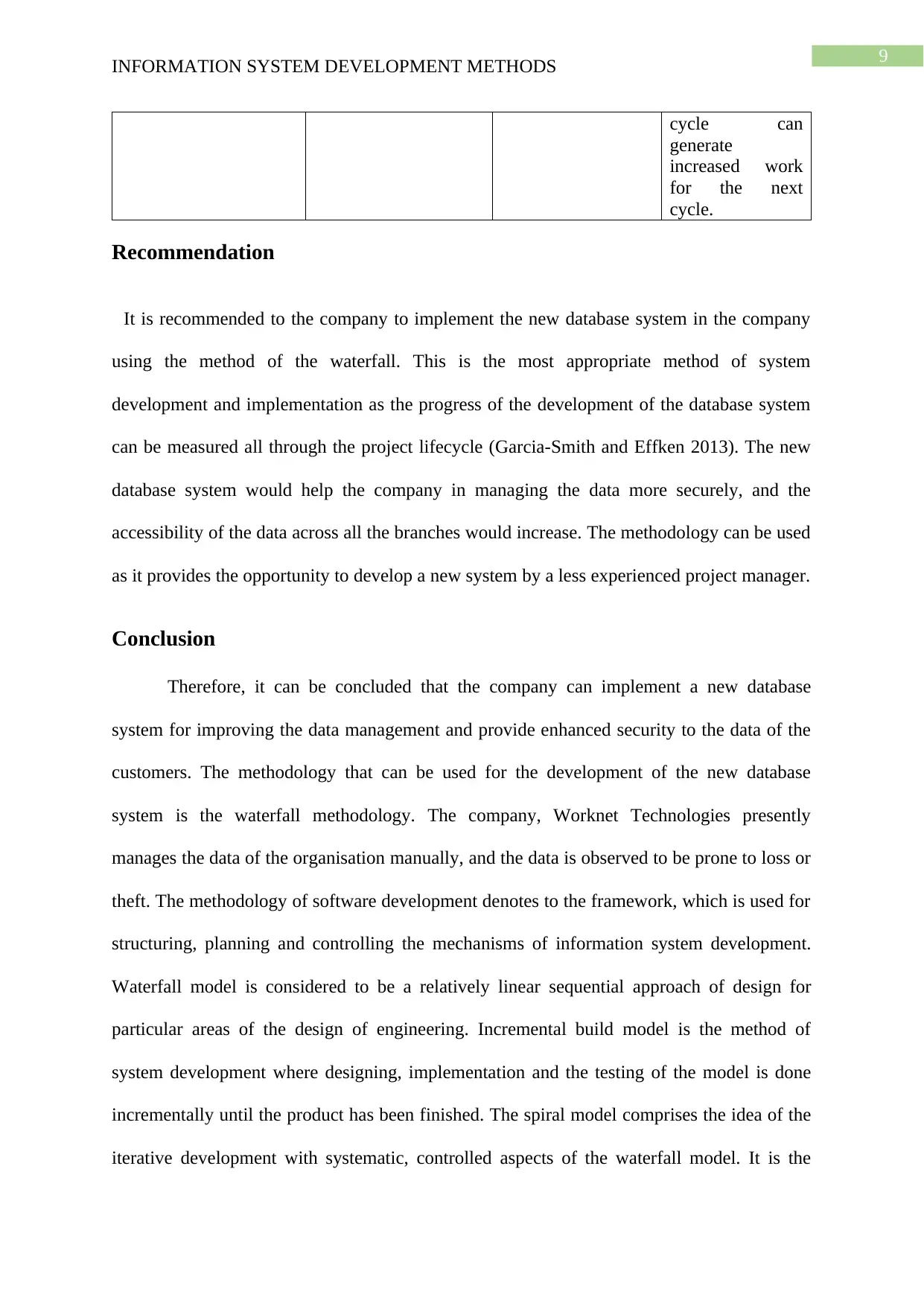
9
INFORMATION SYSTEM DEVELOPMENT METHODS
cycle can
generate
increased work
for the next
cycle.
Recommendation
It is recommended to the company to implement the new database system in the company
using the method of the waterfall. This is the most appropriate method of system
development and implementation as the progress of the development of the database system
can be measured all through the project lifecycle (Garcia-Smith and Effken 2013). The new
database system would help the company in managing the data more securely, and the
accessibility of the data across all the branches would increase. The methodology can be used
as it provides the opportunity to develop a new system by a less experienced project manager.
Conclusion
Therefore, it can be concluded that the company can implement a new database
system for improving the data management and provide enhanced security to the data of the
customers. The methodology that can be used for the development of the new database
system is the waterfall methodology. The company, Worknet Technologies presently
manages the data of the organisation manually, and the data is observed to be prone to loss or
theft. The methodology of software development denotes to the framework, which is used for
structuring, planning and controlling the mechanisms of information system development.
Waterfall model is considered to be a relatively linear sequential approach of design for
particular areas of the design of engineering. Incremental build model is the method of
system development where designing, implementation and the testing of the model is done
incrementally until the product has been finished. The spiral model comprises the idea of the
iterative development with systematic, controlled aspects of the waterfall model. It is the
INFORMATION SYSTEM DEVELOPMENT METHODS
cycle can
generate
increased work
for the next
cycle.
Recommendation
It is recommended to the company to implement the new database system in the company
using the method of the waterfall. This is the most appropriate method of system
development and implementation as the progress of the development of the database system
can be measured all through the project lifecycle (Garcia-Smith and Effken 2013). The new
database system would help the company in managing the data more securely, and the
accessibility of the data across all the branches would increase. The methodology can be used
as it provides the opportunity to develop a new system by a less experienced project manager.
Conclusion
Therefore, it can be concluded that the company can implement a new database
system for improving the data management and provide enhanced security to the data of the
customers. The methodology that can be used for the development of the new database
system is the waterfall methodology. The company, Worknet Technologies presently
manages the data of the organisation manually, and the data is observed to be prone to loss or
theft. The methodology of software development denotes to the framework, which is used for
structuring, planning and controlling the mechanisms of information system development.
Waterfall model is considered to be a relatively linear sequential approach of design for
particular areas of the design of engineering. Incremental build model is the method of
system development where designing, implementation and the testing of the model is done
incrementally until the product has been finished. The spiral model comprises the idea of the
iterative development with systematic, controlled aspects of the waterfall model. It is the
Paraphrase This Document
Need a fresh take? Get an instant paraphrase of this document with our AI Paraphraser

10
INFORMATION SYSTEM DEVELOPMENT METHODS
mixture of the sequential linear development model and the iterative development process
model, and the increased emphasis is on the waterfall model for the risk analysis.
INFORMATION SYSTEM DEVELOPMENT METHODS
mixture of the sequential linear development model and the iterative development process
model, and the increased emphasis is on the waterfall model for the risk analysis.
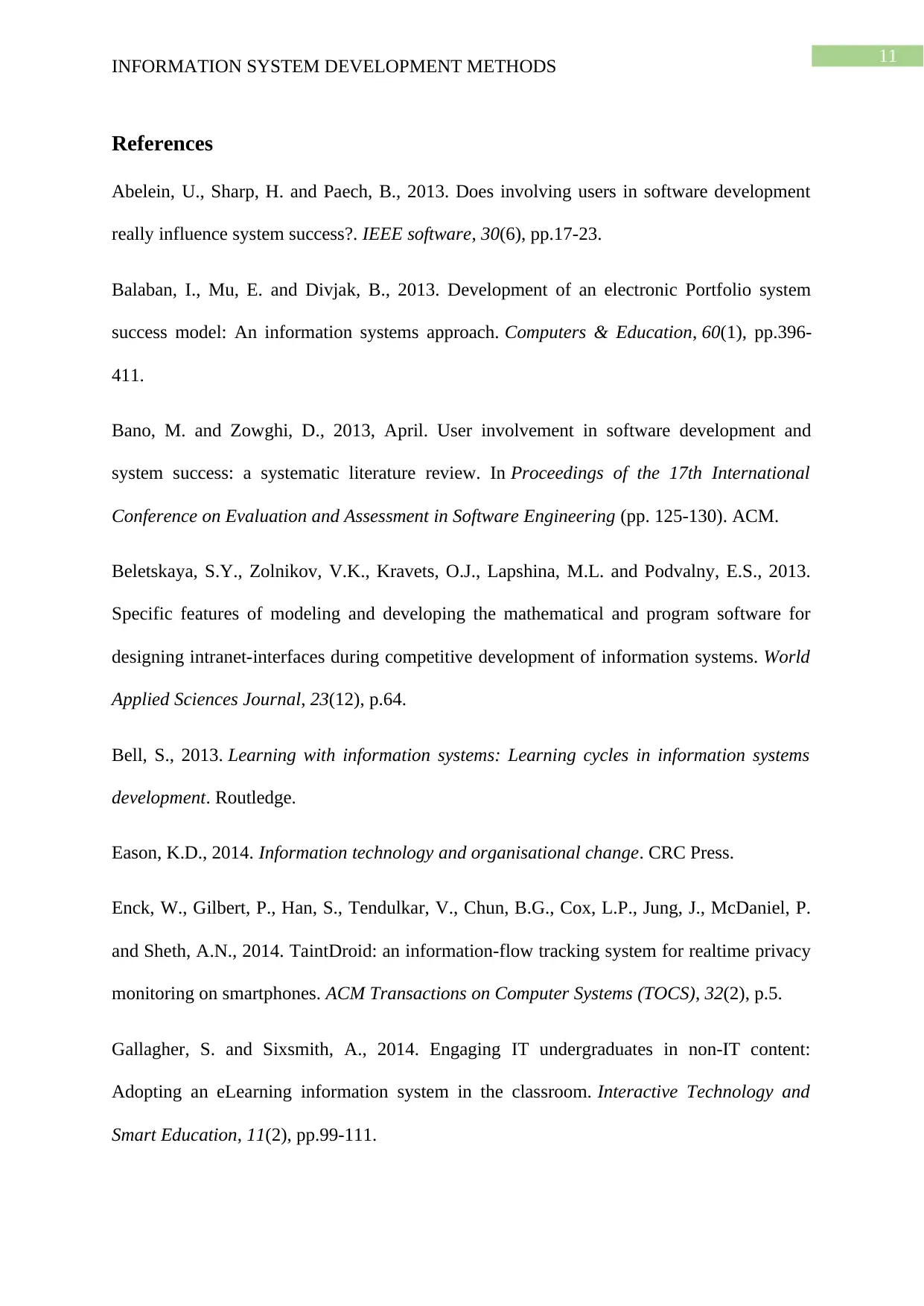
11
INFORMATION SYSTEM DEVELOPMENT METHODS
References
Abelein, U., Sharp, H. and Paech, B., 2013. Does involving users in software development
really influence system success?. IEEE software, 30(6), pp.17-23.
Balaban, I., Mu, E. and Divjak, B., 2013. Development of an electronic Portfolio system
success model: An information systems approach. Computers & Education, 60(1), pp.396-
411.
Bano, M. and Zowghi, D., 2013, April. User involvement in software development and
system success: a systematic literature review. In Proceedings of the 17th International
Conference on Evaluation and Assessment in Software Engineering (pp. 125-130). ACM.
Beletskaya, S.Y., Zolnikov, V.K., Kravets, O.J., Lapshina, M.L. and Podvalny, E.S., 2013.
Specific features of modeling and developing the mathematical and program software for
designing intranet-interfaces during competitive development of information systems. World
Applied Sciences Journal, 23(12), p.64.
Bell, S., 2013. Learning with information systems: Learning cycles in information systems
development. Routledge.
Eason, K.D., 2014. Information technology and organisational change. CRC Press.
Enck, W., Gilbert, P., Han, S., Tendulkar, V., Chun, B.G., Cox, L.P., Jung, J., McDaniel, P.
and Sheth, A.N., 2014. TaintDroid: an information-flow tracking system for realtime privacy
monitoring on smartphones. ACM Transactions on Computer Systems (TOCS), 32(2), p.5.
Gallagher, S. and Sixsmith, A., 2014. Engaging IT undergraduates in non-IT content:
Adopting an eLearning information system in the classroom. Interactive Technology and
Smart Education, 11(2), pp.99-111.
INFORMATION SYSTEM DEVELOPMENT METHODS
References
Abelein, U., Sharp, H. and Paech, B., 2013. Does involving users in software development
really influence system success?. IEEE software, 30(6), pp.17-23.
Balaban, I., Mu, E. and Divjak, B., 2013. Development of an electronic Portfolio system
success model: An information systems approach. Computers & Education, 60(1), pp.396-
411.
Bano, M. and Zowghi, D., 2013, April. User involvement in software development and
system success: a systematic literature review. In Proceedings of the 17th International
Conference on Evaluation and Assessment in Software Engineering (pp. 125-130). ACM.
Beletskaya, S.Y., Zolnikov, V.K., Kravets, O.J., Lapshina, M.L. and Podvalny, E.S., 2013.
Specific features of modeling and developing the mathematical and program software for
designing intranet-interfaces during competitive development of information systems. World
Applied Sciences Journal, 23(12), p.64.
Bell, S., 2013. Learning with information systems: Learning cycles in information systems
development. Routledge.
Eason, K.D., 2014. Information technology and organisational change. CRC Press.
Enck, W., Gilbert, P., Han, S., Tendulkar, V., Chun, B.G., Cox, L.P., Jung, J., McDaniel, P.
and Sheth, A.N., 2014. TaintDroid: an information-flow tracking system for realtime privacy
monitoring on smartphones. ACM Transactions on Computer Systems (TOCS), 32(2), p.5.
Gallagher, S. and Sixsmith, A., 2014. Engaging IT undergraduates in non-IT content:
Adopting an eLearning information system in the classroom. Interactive Technology and
Smart Education, 11(2), pp.99-111.
⊘ This is a preview!⊘
Do you want full access?
Subscribe today to unlock all pages.

Trusted by 1+ million students worldwide
1 out of 13
Related Documents
Your All-in-One AI-Powered Toolkit for Academic Success.
+13062052269
info@desklib.com
Available 24*7 on WhatsApp / Email
![[object Object]](/_next/static/media/star-bottom.7253800d.svg)
Unlock your academic potential
Copyright © 2020–2025 A2Z Services. All Rights Reserved. Developed and managed by ZUCOL.




